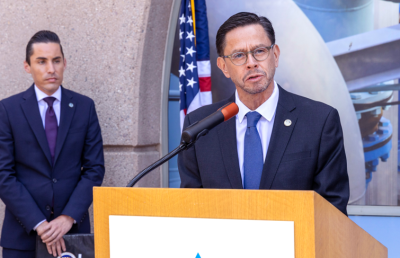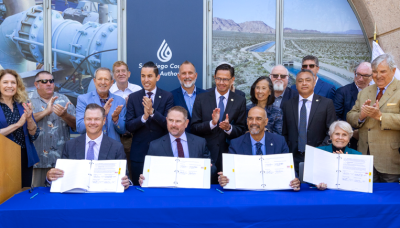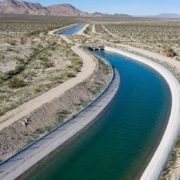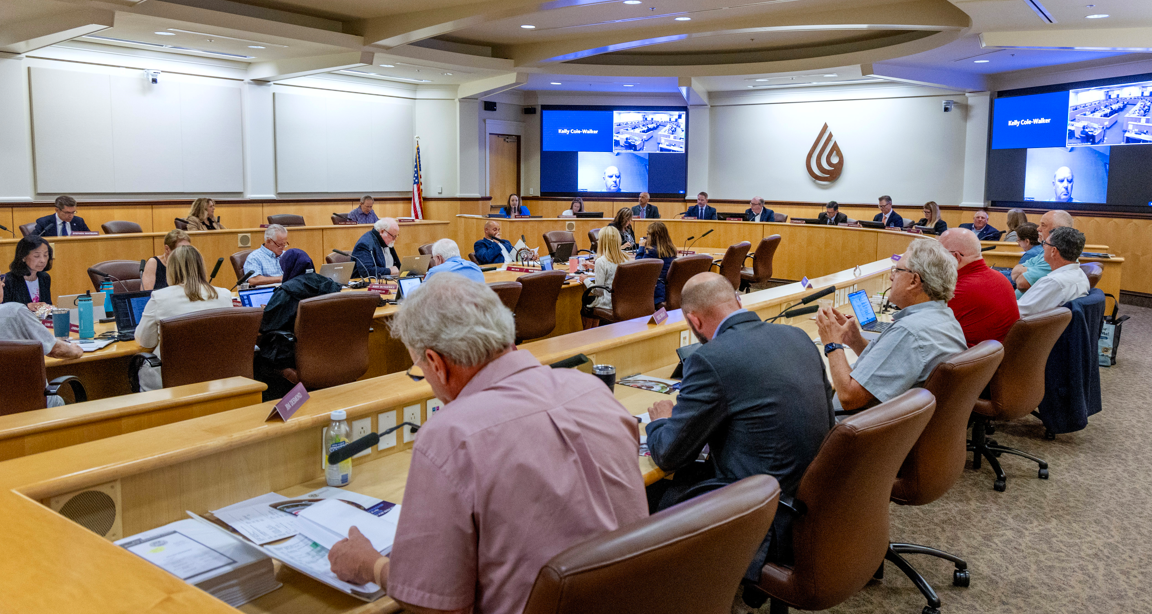Water Authority, MWD End Lengthy Legal Dispute
Signaling a new era of collaboration, the San Diego County Water Authority and the Metropolitan Water District of Southern California today announced the settlement of a 15-year legal dispute over rates and the price term of an exchange agreement between the agencies.
At a news conference in San Diego, leaders from two of the state’s largest water agencies hailed the conclusion of all pending litigation, highlighting their commitment to fostering greater teamwork on a range of issues that affect nearly 19 million Southern California residents. The settlement dismisses all pending appeals, maintaining earlier judicial decisions on various matters. It includes provisions to reduce the potential for future litigation, improve certainty in budgeting, and increase flexibility in efficiently managing water supplies.
“For far too long, this legal battle sat at the center of Metropolitan’s relationship with the Water Authority,” Metropolitan board Chair Adán Ortega, Jr. said. “That era of conflict has finally come to an end and we can forge ahead, building a relationship based instead on cooperation and shared goals that will benefit the entire region. The agreement is acknowledgement of a regional approach to water supply management with mechanisms to efficiently squeeze every drop of water to assure future prosperity and our quality of life while protecting the sources of water we all depend upon.”
The agreement also opens a pathway for San Diego to provide water to other water agencies in Metropolitan’s service area.
“Ratepayers and water users across Southern California are the winners in this settlement. It provides a new revenue opportunity for San Diego, a new water supply opportunity for other communities, and greater budget certainty for the entire region,” said Water Authority board Chair Nick Serrano. “Only by working together could we produce these results. I greatly appreciate our colleagues at Metropolitan for their willingness to move past years of disagreement and chart a brighter future.”
Serrano made ending the litigation a cornerstone of his term that started in October 2024. He thanked prior Water Authority board leaders, including Chair Emeritus Mel Katz, for years spent laying the groundwork with Metropolitan’s Board Chair Ortega.
Ortega shared his gratitude.
“I greatly appreciate the partnership of board Chair Serrano and former Chair Katz, who serves on Metropolitan’s board, as well as the work of my Metropolitan board colleagues Vice Chair Nancy Sutley, Director Desi Alvarez and the members of Metropolitan’s ad hoc committee on the San Diego litigation, as we set the groundwork of trust that made this agreement possible.”

Metropolitan Water District Board Chair Adán Ortega, Jr. speaks at the press conference announcing an end to litigation.
The litigation centered on the price the Water Authority pays to Metropolitan for an exchange of water. The Water Authority has acquired conserved Colorado River water from two sources: the Water Authority purchases water from the Imperial Irrigation District, and Metropolitan assigned to the Water Authority water conserved by the lining of the All-American and Coachella canals.
This conserved Colorado River water totals up to 277,700 acre-feet a year (an acre-foot is about 326,000 gallons, enough to serve roughly three Southern California families for a year). The conserved Colorado River water is provided to Metropolitan at the Colorado River and, in exchange, Metropolitan delivers the same quantity of its water to San Diego. The Water Authority repeatedly challenged the price Metropolitan charged for this exchange starting in 2010, with both sides winning important legal judgments over more than a decade.
Under the settlement, the Water Authority will pay a fixed price to Metropolitan for delivery of the exchange water, adjusted annually for inflation. The price will no longer be tied to Metropolitan’s rates, which was a source of dispute and litigation. In addition, the Water Authority will be able to offer those deliveries to other Metropolitan member agencies or to sell the conserved Colorado River water to Metropolitan.
“This agreement will allow San Diego to take advantage of our past investments in diverse water supplies to benefit regional ratepayers while addressing water reliability challenges more broadly,” Water Authority General Manager Dan Denham said. “We look forward to building on the foundation of collaboration laid today.”

Board members and leaders from the San Diego County Water Authority and the Metropolitan Water District celebrate the end of 15 years of litigation.
“And from Metropolitan’s perspective, the agreement provides increased revenue certainty, potential access to additional water, and the confidence that years of litigation are behind us,” Metropolitan General Manager Deven Upadhyay said. “Today truly marks a new beginning. Through dialogue, negotiation and mutual understanding, we have found a common path forward. And we are all far better off for it.”
The settlement agreement was drafted and refined over the past year by Ortega, Upadhyay, General Counsel Marcia Scully and Metropolitan’s in-house litigation team, who worked with the Water Authority team of Serrano, Katz, Denham and General Counsel David Edwards.
Settlement Agreement Highlights
• Pending appeals are dismissed, all previous final judicial decisions remain in place and parties retain already decided attorneys’ fees and costs awarded.
• Water Authority to pay Metropolitan an agreed upon fixed price for the delivery of exchange water, instead of the past price that was based on Metropolitan’s rates. The fixed price will start at $671 per acre-foot in 2026, and increase annually based on a specified consumer price index escalator.
• Water Authority to pay Metropolitan a fixed payment for 227,000 acre-feet of exchange water a year, rather than making payments based on volume of water exchanged. If more than 227,000 acre-feet of water is exchanged, then the Water Authority will pay the unit price based on volumetric deliveries.
• Provides Water Authority potential new revenue. The Water Authority can first offer to Metropolitan member agencies the right to receive exchange water, and then can offer to Metropolitan the right to purchase conserved water.
• Metropolitan and Water Authority will meet every five years to discuss ongoing implementation of the Exchange Agreement.







